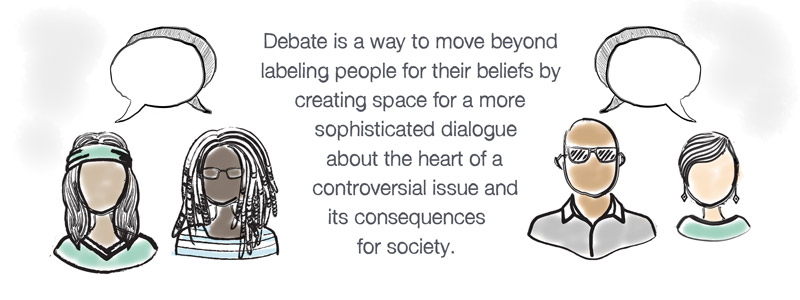RESOURCE 2
Using Debate to Navigate Difference

The nature of debate topics, opportunities for uninterrupted air time, structured formats, and the fact you often can’t choose your side give people permission to take risks and explore different viewpoints. Debate can make it easier to feel prepared to respond when issues become more personal and harder to manage. Unfortunately, opportunities to participate in competitive debate tend to be made more available in well-resourced schools and communities, due to the expense of the activity, need for expert coaches, and heavy weekend and volunteer commitments. Outside of competitive debate after school, quality debate instruction is difficult to find. Classrooms often prioritize discussion over debate, focusing on consensus-building over clash. To prepare students for controversies they will face in the world, however, every student needs access to rigorous, academic debates that help them learn from (rather than fear) difference.
The Debate About Debate
For students, the very qualities that make debate exciting for some make it feel impossible for others, which is why debate is difficult to make inclusive without careful design. For instance, poorly designed debate can exacerbate inequities in prior background knowledge, including gaps in academic language, reading and research skills, literacy, and experience with conversations about current events. The competitive nature of debate can be intimidating for more introverted students, especially if the debate culture relies on speed and aggression as the accepted norms for speaking. Debate can also tap into fundamental fears of being judged and evaluated in front of others, where students are scared of being wrong or not feeling prepared enough to speak spontaneously. This fear is even worse when students are assigned to a side that they do not want to defend, and the lack of choice can feel overwhelming.
So why is debate still worth it? While it is true debate can be intimidating and scary at first, facing this in a classroom is a lot better than having to face it for the first time when you are advocating for yourself or presenting on the job. Competition, speed, and aggression are tactics that many rely on to silence others, and debate can familiarize students and teach them they are capable of responding in these situations. When debate is taught and practiced in a culture that supports risk-taking and strengthens teamwork, students learn it is not possible to be “right” all the time and that it is possible to improve. When repeated often over time (rather than a single assignment), taking another side promotes understanding and perspective-taking by asking students to seek the nuance in every argument and examine different philosophies and world views. With practice, students can find enjoyment in debate, which also provides the incentive and exposure necessary to improve academic language and literacy.
Making Debate Accessible and Inclusive
To reap the benefits of debate, it is important to help students handle the initial intimidation and feeling that only some people can ever be “good”. The culture of the classroom is especially important and feeling a sense of belonging to a team can act as a buffer from any overwhelming fears. Teaching debate should take a developmental approach, where students are gradually introduced to new skills and opportunities to practice them. Every challenge should be accompanied by something fun: if the skill is hard, then the topic should be silly and light and if the topic is hard, then the skill should be familiar. The key is to balance areas of comfort and discomfort for everyone and each student should have the chance to feel both successful and like they need to grow to overcome hurdles. Some starting points:
- Teach each step in a debate format using easy, accessible topics that the students generate themselves (e.g. Skittles are better than M&Ms, Cows are better than Horses). As they learn something new, give them tools such as templates or sentence starters to use as a guide and help them participate right away.
- After they have learned the format, choose topics that are personally relevant and controversial, such as philosophical debates involving morality (e.g. It is more important to help yourself than to help society). Gradually ease them into more unfamiliar topic territory, where they may not initially understand the ideas.
- Support background knowledge and topic exploration outside of competition. Before they have to take a side, help them research both sides and identify the heart of an issue.
- Lower the stakes by first having students debate and prepare in larger groups, followed by working in pairs and then working alone. Mix up the groupings and help students find partners who help them feel better prepared.
- When it comes to style, emphasize persuasion and audience connection over imitation. It can be tempting to want to sound as loud and aggressive as everyone else, but regularly remind students that they need to find their own style and approach to persuading their listeners. Shouting matches rarely help understanding.
The Final Takeaway
Students do not get access to the benefits of debate when they are not exposed to the activity and when they do not have the time to develop the skills necessary to enjoy it. Like any form of public speaking, it is hard to participate when faced with fear and discomfort. The point of debate goes beyond winning; it prepares students to understand diverse viewpoints and navigate difference without getting intimidated by disagreement. Without the chance to engage deeply with issues and clash directly with ideas, it is hard to formulate informed opinions. Classrooms are an ideal practice setting for helping students experiment with their ideas and avoid being silenced when it matters. When properly designed, debate is always worth it.


